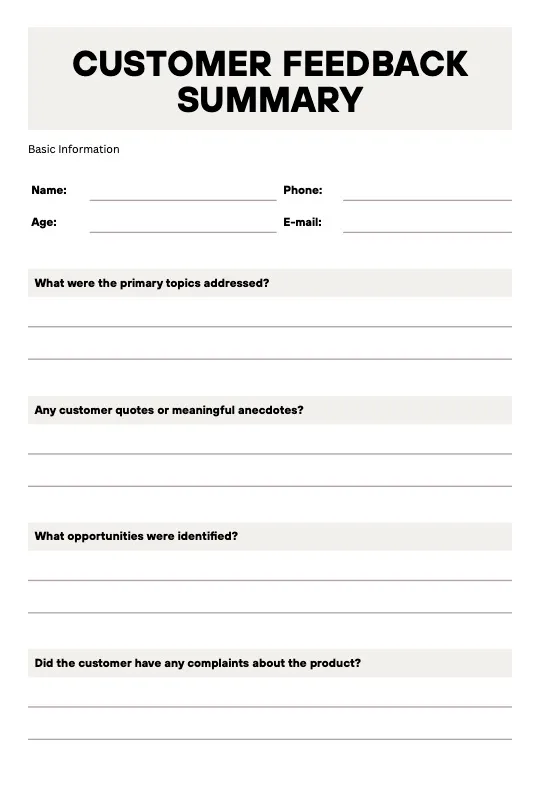If you’ve been in product management for any length of time, you’ll start to realize how critical customer feedback is for your job. Without knowing what customers need and want, it can be difficult, if not impossible, to make the right decisions — when to tackle a nagging bug, when to work through a UX problem, and how to decide how much effort should go into revamping an old feature.

Customer feedback can come from everywhere, so how do you analyze it properly? And how can you be sure you’ve gotten at the heart of what customers are saying?
In this article, you will learn what customer feedback analysis is, best practices for creating effective feedback loops, and how to incorporate feedback into your product development.
Customer feedback analysis is the art and science of taking disparate data sources and feedback points from your customers and synthesizing them into clear, concise insights. These insights can then be used to more deeply understand your customers, better communicate with them, design more intentional UX, and create meaningful product experiences that help your customers achieve their goals.
The most important thing to keep in mind when analyzing customer feedback is to clearly identify the problem the customer had, which will then help you identify the opportunity. A problem might sound like, “I couldn’t find anything to listen to today on my commute.” Or, “I couldn’t login to the website, and I never got the password reset email.”
These are both problem statements. The first one might lead to an opportunity that sounds like, “Help people discover content for their commute.” The second might need to be prioritized as a bug ticket. Either way, both are clear customer problems that need to be solved.
Customer feedback can come from anywhere, especially if you have a large, business-to-consumer (B2C) product with mass appeal, like a social media platform.
Because of this, customer support tickets can be a great source of what goes wrong in your product. If you aren’t already seeking feedback from your customer support team, this can add a lot of flavor to issues you may need to fix. Prioritizing these issues may also help you reduce churn in the long run.
There are lots of tools that make gathering customer feedback easier, including in-app surveys, but it takes time. Customer feedback analysis can take quite a bit of time, and it is important to set aside time weekly, if not daily, to stay in touch with what your customers are saying.
Check your bias. We often get excited about one idea or one problem, but that may not be the thing that is most important to customers. Frequently check to see if you are unintentionally interpreting feedback into insights to support your favorite idea. If you can take an unbiased step back, you might be surprised by what you find and it may help your product be even more effective.
It’s important to keep your team and stakeholders aware of what you’re learning and discovering from customers so that it’s easier to get buy-in on your roadmap and plans for future features and development.
The easiest way to do this is to develop a template. You can use this template to easily share insights you’ve gained during your recent customer conversations.
The goal is to keep your template skimmable — you want it to be easy to read, easy to understand, and quickly give you the basics that are most important to remember from the conversation.
In analyzing customer feedback, the goal is to identify the customer’s problem and any information that led you to identifying that problem. It could be a quote from a customer, a one-sentence summary or it might be a video clip that you can attach to your customer feedback summary.
Be sure to include:

As you collect customer feedback, cataloging the opportunities that you have collected from customers can help prioritize your features. As you keep talking to customers, you’ll discover themes. Or, you might find that one opportunity is especially important to prioritize in the next sprint.
You want to find ways to keep the customer front of mind so that you build for the right people at the right time. Without keeping the customer front of mind, the customer experience might drift or you might start building with someone else in mind.
One way to ensure that you are keeping the customer front of mind when developing new features, prioritizing bugs, or solving user experience issues is to have a regular rhythm of reviewing customer feedback with your team.
You can incorporate this rhythm in a variety of ways. One way is to simply share a brief piece of customer feedback every morning during stand-up. Another way to do this is to have a monthly feedback review, where you look over all the customer feedback collected in the last month and see what opportunities there are for solving customer problems, especially if any have risen in importance.
Oftentimes, if you have a clear outcome, knowing what problems to solve in order to achieve that outcome can become much easier if using a template like the one above. You can quickly mark which pieces of feedback follow the same themes.
If using a digital tool for feedback tracking like Coda or Notion, it becomes very easy to search or tag those pieces of customer feedback in order to see how much of the feedback you are receiving is related. This can make it much easier when it comes to setting quarterly priorities if all of your feedback is cataloged and available at your finger-tips.
With the advent of AI, especially tools for specifically analyzing large groups of feedback, it has become even faster to take large swaths of customer interviews, notes from customers, customer survey data and more and analyze it to quickly turn it into insights. What used to take many manual hours can now be assisted by machine
Not only can they analyze the feedback, they can quickly turn it into a prioritized list of opportunities. At this stage, you’ll still need to read through and make sure that these tools provide the right prioritization according to your goals, OKRs or outcomes.
Customer feedback analysis is so important that well-known people in the product space recommend ensuring you have at least four hours per day set aside to learn from customers and think about the feedback they’ve provided.
When you analyze feedback, you’re looking for problems and opportunities. Whether you’re looking at a set of interview notes from a customer, or you’re looking at a customer support ticket, try to identify a clear problem and let that problem lead to the opportunity that your team could develop.
Customer feedback analysis becomes easier if you use a template. And don’t be afraid to utilize a new AI tool to make it easier and faster to analyze lots of pieces of customer data.
Featured image source: IconScout

LogRocket identifies friction points in the user experience so you can make informed decisions about product and design changes that must happen to hit your goals.
With LogRocket, you can understand the scope of the issues affecting your product and prioritize the changes that need to be made. LogRocket simplifies workflows by allowing Engineering, Product, UX, and Design teams to work from the same data as you, eliminating any confusion about what needs to be done.
Get your teams on the same page — try LogRocket today.

Most teams fail at autonomy. Learn how clear rules help product teams move faster without micromanagement.

A practical framework for PMs to use AI in ideation without sacrificing judgment, strategy, or decision quality.

A practical five minute revenue estimation method to help product managers compare ideas, drop low impact features, and prioritize smarter.

A practical guide for PMs who want to stop being bottlenecks, delegate smarter, and lead teams effectively with a clear ownership framework.